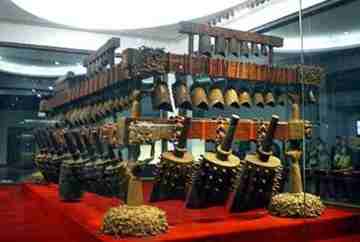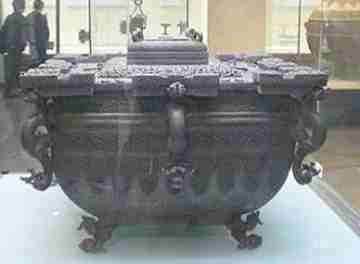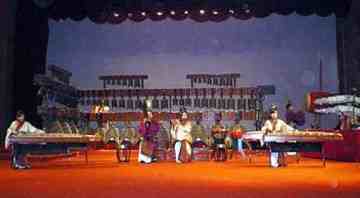A feudal lord of the Chu kingdom takes his love of wine and music with him into the afterlife. TWO thousand four hundred years ago, a nobleman lived surrounded by luxury in a small state in the northern part of contemporary China’s Hubei province.
 His name was Yi and he was Marquis of Zeng (Zeng-hou), a vassal of the Chu kingdom and so obscure no one knew of its existence until archaeologists discovered the Marquis’ tomb in 1977.
His name was Yi and he was Marquis of Zeng (Zeng-hou), a vassal of the Chu kingdom and so obscure no one knew of its existence until archaeologists discovered the Marquis’ tomb in 1977.
Though his territory was not particularly large or significant, Zeng-hou Yi, as he was called, possessed all the trappings of a wealthy, important aristocrat.
He lived in a culture where music played a key role in rituals and ceremonies so it is no surprise that his prized possession was a magnificent set of 65 bronze bianzhong (chime bells) which took pride of place in his mansion’s main reception hall.
These meticulously-cast bells, the largest of which is over 1.5m tall and weighs over 200kg, were so technologically advanced each was capable of generating two tones depending on where they were struck.
They were inscribed with musical notations and could produce the seven-tone scale in five octaves, complete with semitones.
Zeng-hou Yi also possessed a set of 32 bianqing (flat stone chimes) mainly of polished marble, as well as ancient musical instruments like the qin and se zithers, drums and pipes; in total, a staggering 125 pieces of instruments that leave no doubt as to the importance of music in Chu-dominated cultural life.
The Marquis’s bianzhong, bianqing and the more than 15,000 relics unearthed from his tomb are now housed in the fabulous Hubei Provincial Museum in Wuhan.
An entire hall is dedicated to these finds which include his red-lacquered inner coffin densely covered with motifs comprising hundreds of small interlaced swirling dragons, serpents and mythical spirits as well as geometric patterns.
A natural accompaniment to music is, of course, wine which Zeng-hou Yi apparently imbibed in prodigious quantities. His tomb yielded what is surely some of the largest wine vessels ever produced for personal use, chief amongst them a bronze jar 1.26m tall, 1m wide and weighing 327kg. The mind boggles as to how much wine this oversized container can hold.
 The most startling item in Zeng-hou Yi’s hall has got to be one that recalls the large square bronze drums played by 2,008 drummers during the Opening Ceremony of the 2008 Beijing Olympics.
The most startling item in Zeng-hou Yi’s hall has got to be one that recalls the large square bronze drums played by 2,008 drummers during the Opening Ceremony of the 2008 Beijing Olympics.
The “drum” is in fact a 2,400-year-old oversized bronze wine cooler which comprises a jar (fou) set inside a square-shaped container (jian). Ice was then poured into the space between the jian and fou.
According to our guide, the fou drums of the Beijing Olympics Opening Ceremony were inspired by this ingenious contraption which even comes with a matching wine filter and a long-handled serving ladle.
Zeng-hou Yi enjoyed his wine and music parties so much that he took his entertainers – a troupe of dancers and musicians, with him to his grave.
A chart near his lacquered coffin in the exhibition hall lists in detail the age and height of the 13 young female retainers buried in a tomb chamber. Their ages ranged from as young as 13 to 26.
In addition, the Marquis brought along with him his pet dog and eight wives under the age of 30 who were found in his private tomb chamber together with qin and se, ostensibly to play soothing music to help him sleep in the afterlife.
Besides the musical instruments and bronze vessels, Zeng-hou Yi’s tomb overflowed with lacquer household utensils, as well as gold and jade accessories and weapons.
His high status was evidenced by the presence of nine bronze ding (cooking vessels) signifying his authority to rule, and upon his death the powerful King of Chu granted him an inscribed memorial bell.
A model of the tomb complete with main hall, retainers’ quarters and private chambers reflects his luxurious existence on Earth.
 Walking through the gallery, I could not help but wonder, if a lesser nobleman could live so extravagantly, what would we find in the tombs of the kings of the larger and more powerful states of ancient China?
Walking through the gallery, I could not help but wonder, if a lesser nobleman could live so extravagantly, what would we find in the tombs of the kings of the larger and more powerful states of ancient China?
The Hubei Provincial Museum has several other equally superb galleries featuring 2,000-year-old lacquerware, early ceramics and some of the oldest writings on bamboo slips, hundreds of years before the invention of paper.
There is also a hall dedicated to Chu culture, as well as a gallery with splendid artefacts from the tomb of Ming dynasty Prince Liangzhuang who was contemporaneous with Admiral Zheng He.
Short, 15-20 minute performances of bianzhong and bianqing ancient court music as well as dances of the Chu period give visitors a taste of Chu’s sensuous culture.
This museum is truly a must-visit for anyone interested in Chinese history and civilisation, and the two and half hours we spent there were barely enough to cover just two or three galleries.
Author: Ziying | Source: The Star [December 29, 2010]